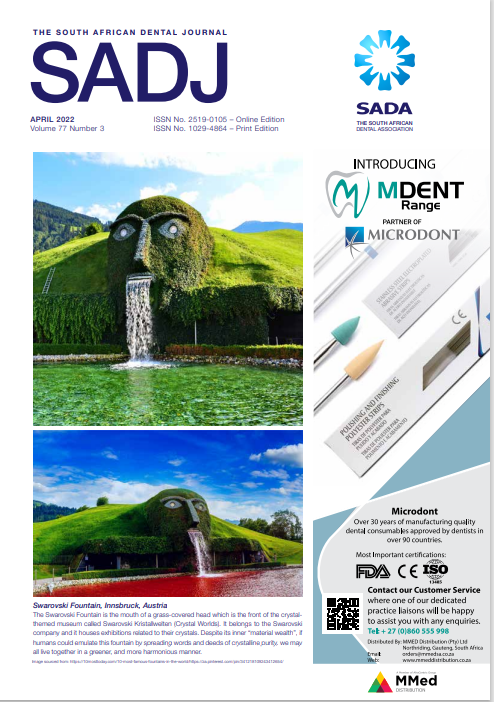Prevalence of Sharps Injuries at a Tertiary Teaching Oral Health Centre, Gauteng, South Africa
DOI:
https://doi.org/10.17159/2519-0105/2022/v77no3a2Keywords:
Needle-stick, sharps injuries, dentistry, training institutionAbstract
Needle-stick and sharps injuries are an occupational hazard in dental training institutions. The study aimed to quantify and describe the nature of Needle-stick and sharp injuries (NSI) at a Tertiary Teaching Oral Health Centre (TTOHC) in South Africa. An analytic, cross-sectional study was conducted among students engaged in clinical service and oral health staff supervising them at the Oral Health Centre, Gauteng, South Africa. An adapted 18-item self-administered questionnaire was provided to all students and staff. Standard ethical guidelines were followed according to institutional ethics committee approval (M171131). A response rate of 88% (n=73) was obtained from students, with the majority of participants being female(67%), dentistry students (88 %), aged between 18-25 years, in their fourth year of study (45%) while only 3.7% were final year oral hygiene students. The staff participants were dentists (80.6%)
while most staff participants (88.3%) were employed for 3 years or less. The NSI prevalence at the TTOHC was 41.3% (n=45). The number of staff reporting the injury for both staff and students was recorded to be 80% (n = 36 of 45 injuries), with 77.3% of injured individuals receiving post-exposure prophylaxis (PEP) against possible HIV-infection, however, more than a third (39%) reported not to have completed the PEP. The department in which the most NSIs occurred was Maxillofacial and Oral Surgery. Sharp injuries were mostly due to needle sticks. Most NSIs occurred among senior students with more clinical experiences and particularly during the
early and late periods in a year. The prevalence of needle and sharp injuries was high and of concern. The sharps injury reporting rate was good, however, less than half of injured individuals completed the PEP treatment. The findings highlighted which students were
most at risk to encounter NSI, including the period during their training when it was most likely to occur, thus enabling directed re-emphasis and training in Infection Control and Prevention.
Downloads
References
Himmelreich H, Rabenau HF, Rindermann M, Stephan C, Bickel M, Marzi I, et al. The management of needlestick injuries. Deutsches Ärzteblatt International. 2013;110(5):61.
Lee J-J, Kok S-H, Cheng S-J, Lin L-D, Lin C-P. Needlestick and sharps injuries among dental healthcare workers at a university hospital.
Journal of the Formosan Medical Association. 2014;113(4):227-33.
Leggat PA, Smith DR, Speare R. Exposure rate of needlestick and sharps injuries among Australian veterinarians. Journal of occupational medicine and toxicology. 2009;4(1):25.
Jaber MA. A survey of needle sticks and other sharp injuries among dental undergraduate students. Int J Infect Control. 2011;7(3):1-10.
Mungure E, Gakonyo J, Mamdani Z, Butts F. Awareness and experience in needle stick injuries among dental students at the University of Nairobi, Dental Hospital. East African medical journal. 2010;87(5):211-4.
Siddiqi A, K Niazi M, De Silva H, Firth N, Konthasingha P, Zafar S. Percutaneous exposure incidents: a review of practice and awareness of current protocols at a Dental Faculty. Oral Surgery. 2017;10(4):e80-e7.
Ingole K, Pawar S, Pathak S. Needle Stick Injuries among Health Care Worker at Tertiary Care Hospital. Int J Curr Microbiol App Sci. 2016;5(12):718-25.
Hasak JM, Novak CB, Patterson JMM, Mackinnon SE. Prevalence of needlestick injuries, attitude changes, and prevention practices over 12 years in an urban academic hospital surgery department. Annals of surgery. 2018;267(2):291-6.
Coppola N, De Pascalis S, Onorato L, Calò F, Sagnelli C, Sagnelli E. Hepatitis B virus and hepatitis C virus infection in healthcare workers. World journal of hepatology. 2016;8(5):273.
Green B, Griffiths E. Psychiatric consequences of needlestick injury. Occupational medicine. 2013;63(3):183-8.
Choi LY, Torres R, Syed S, Boyle S, Ata A, Beyer TD, et al. Sharps and needlestick injuries among medical students, surgical residents, faculty, and operating room staff at a single academic institution. J
Downloads
Published
Issue
Section
License
Copyright (c) 2022 Neil Wood

This work is licensed under a Creative Commons Attribution-NonCommercial 4.0 International License.






.png)